Trinket-Pro-PinOut
Broches d'alimentation
| There are two versions of the Pro Trinket: 3V and 5V. They are almost identical but there are slight differences in the pinouts: one has a 3V output pin in the top right, the other has a 5V output pin instead |

Crédit: AdaFruit Industries www.adafruit.com
We'll start with the top pins BAT+, USB+, 3V/5V, and GND
- BAT+ is the Battery + Input pin. If you want to power the Pro Trinket from a battery or power adapter or solar panel or any other kind of power source, connect the + (positive) pin here! You can connect up to 16V DC. If you have a 3V Pro Trinket, you'll want at least 3.5V input to get a good 3.3V output. If you have a 5V Pro Trinket, 5.5V or higher is suggested. This input is reverse-polarity protected.
- BUS is the USB Bus + Output pin. If you want to use the USB 5V power for something, like charging a battery, or if you need more than 150mA of current (this pin can supply 500mA+ from USB ports) or to detect when the Pro Trinket is plugged into USB, this pin will have 5V power on it if and only if its plugged into something via the mini B connector
- GND is the common ground pin, used for logic and power. It is connected to the USB ground and the power regulator, etc. This is the pin you'll want to use for any and all ground connections
Broches GPIO
Next we will cover the 18 GPIO (General Purpose Input Ouput) pins! 18 GPIO is a big step up from the little Trinket with only 5 or so pins. This is almost as many as a 'full grown' Arduino. In fact, since the Pro Trinket uses the same core chip as an Arduino, nearly any existing project that uses special pins like hardware PWM or SPI will work 'out of the box'.
All the GPIO pins can be used as digital inputs, digital outputs, for LEDs, buttons and switches etc. They can provide up to 20mA of current. Don't connect a motor or other high-power component directly to the pins! Instead, use a transistor to power the DC motor on/off.
Niveau logique
On a 3V Pro Trinket, the GPIO are 3.3V output level, and should not be used with 5V inputs. On a 5V Pro Trinket, the GPIO are 5V output level, and can be used with 3V inputs but may damage electronic devices that are 3V input only!
Les broches GPIO digitales
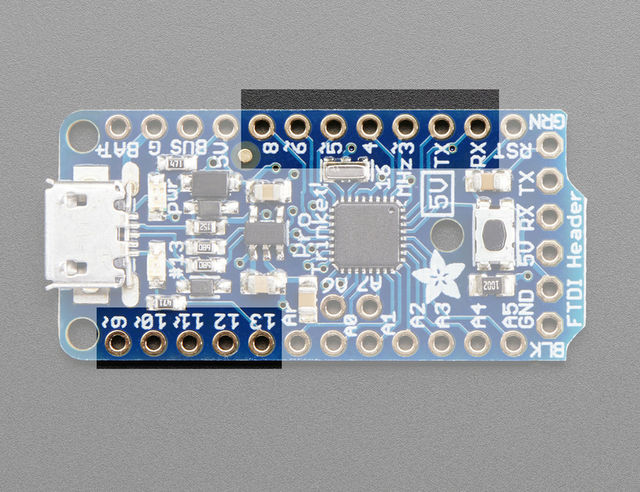
Crédit: AdaFruit Industries www.adafruit.com
- RX - also known as Digital #0, this is the hardware serial input pin
- TX - also known as Digital #1, this is the hardware serial output pin
- Digital 3 - this pin can also be used as a PWM output pin using analogWrite()
- Digital 4 - Nothing particularly special about this GPIO pin
- Digital 5 - this pin can also be used as a PWM output pin using analogWrite()
- Digital 6 - this pin can also be used as a PWM output pin using analogWrite()
- Digital 8 - Nothing particularly special about this GPIO pin
- Digital 9 - this pin can also be used as a PWM output pin using analogWrite() It's also good for driving servos because its a high-speed PWM output
- Digital 10 - this pin can also be used as a PWM output pin using analogWrite() It's also good for driving servos because its a high-speed PWM output
- Digital 11 - Also known as the SPI MOSI pin. this pin can also be used as a PWM output pin using analogWrite()
- Digital 12 - Also known as the SPI MISO pin
- Digital 13 - Also known as the SPI CLOCK pin
Les broches GPIO analogiques/digitales
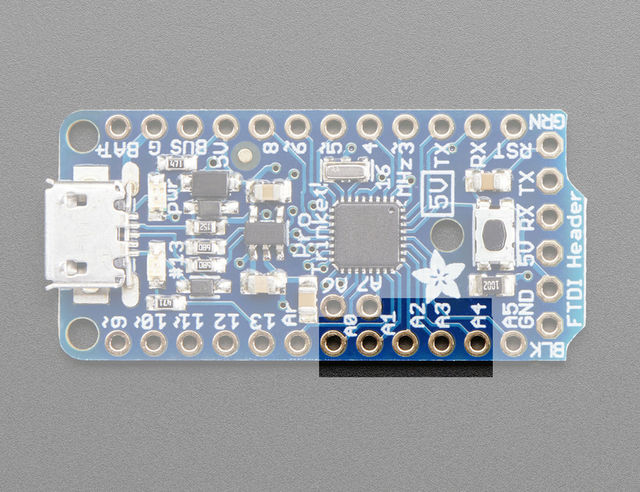
Crédit: AdaFruit Industries www.adafruit.com
- Analogique 0 - also known as Digital 14, this pin can be a digital I/O pin or an analog input pin
- Analogique 1 - also known as Digital 15, this pin can be a digital I/O pin or an analog input pin
- Analogique 2 - also known as Digital 16, this pin can be a digital I/O pin or an analog input pin
- Analogique 3 - also known as Digital 17, this pin can be a digital I/O pin or an analog input pin
- Analogique 4 - also known as Digital 18, this pin can be a digital I/O pin or an analog input pin. It's also the I2C SDA pin
- Analogique 5 - also known as Digital 19, this pin can be a digital I/O pin or an analog input pin. It's also the I2C SCL pin
Les broches analogiques uniquement
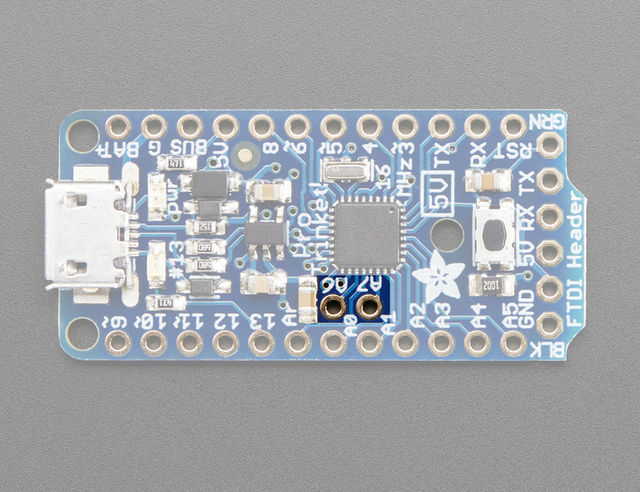
Crédit: AdaFruit Industries www.adafruit.com
The two pins that sit sort-of inside the body of the Pro Trinket, A6 and A7, are analog input only pins. They're kind of an 'extra' that you get with the Pro Trinket. These pins cannot be used for LEDs, buttons, servos, etc. They're only for analogRead() usage!
If you're used to using an Arduino Uno, you may notice that pins #2 and #7 are not available. That's because we use those two pins for the USB bootloader. They are not available for use and are not broken out.
Les autres broches
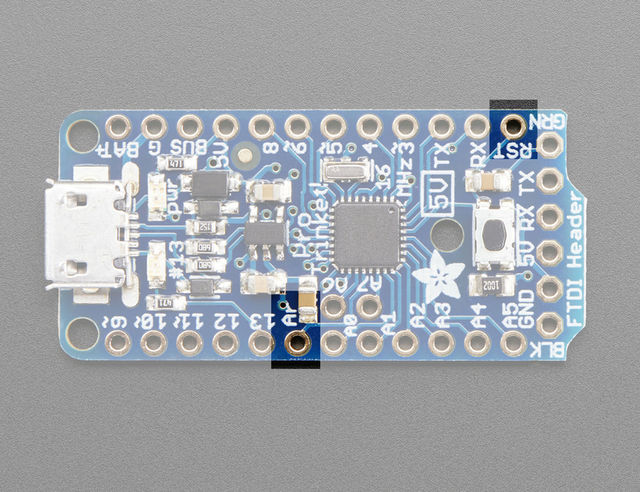
Crédit: AdaFruit Industries www.adafruit.com
- Aref - this is the optional analog reference pin for the analog converter, to be used when you want the 'top' of the analog converter to be different than 3V or 5V. Connect this to your desired reference voltage (between 0 and the Pro Trinket voltage) and use analogReference(EXTERNAL)
- RST - This is the Reset pin for the Pro Trinket. Connecting this to ground momentarily resets the Trinket and also starts up the bootloader.
Le connecteur FTDI
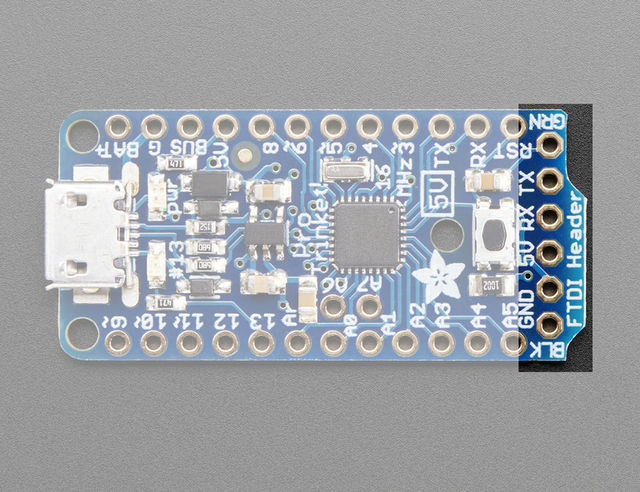
Crédit: AdaFruit Industries www.adafruit.com
At the bottom is 6 pins in a row that we call the FTDI header. You can use these pins to program the Pro Trinket with an FTDI cable or FTDI Friend. You can also use it for serial debugging.
- GND - same as the power ground pins
- 5V - same as the VBUS pin
- RX - same as the RX pin
- TX - same as the TX pin
- RST - there's a 0.1uF capacitors in between this pin and the Reset pin, so that Arduino-compatible programmers will work correctly with the DTR/RTS-toggle technique
Source: Introducing Pro Trinket réalisé par Ladyada pour AdaFruit Industries. Crédit AdaFruit Industries
Traduit par Meurisse.D. pour MCHobby.be
Traduit avec l'autorisation d'AdaFruit Industries - Translated with the permission from Adafruit Industries - www.adafruit.com
Toute référence, mention ou extrait de cette traduction doit être explicitement accompagné du texte suivant : « Traduction par MCHobby (www.MCHobby.be) - Vente de kit et composants » avec un lien vers la source (donc cette page) et ce quelque soit le média utilisé.
L'utilisation commercial de la traduction (texte) et/ou réalisation, même partielle, pourrait être soumis à redevance. Dans tous les cas de figures, vous devez également obtenir l'accord du(des) détenteur initial des droits. Celui de MC Hobby s'arrêtant au travail de traduction proprement dit.